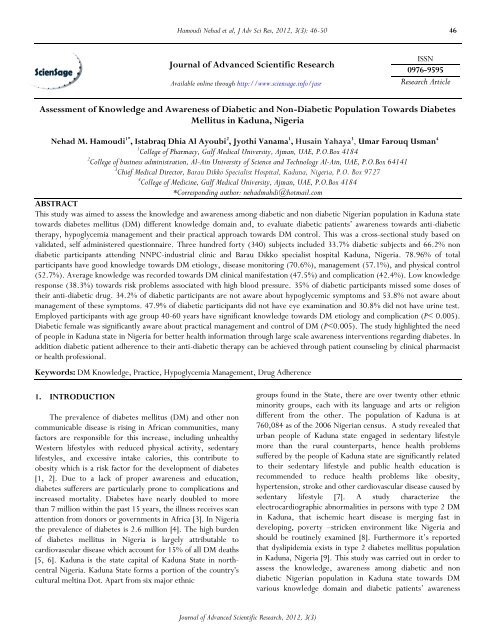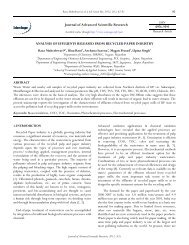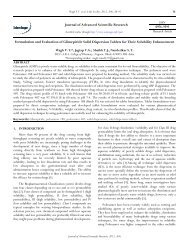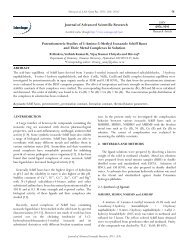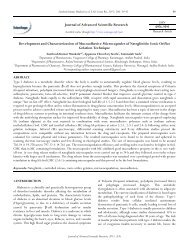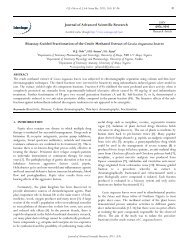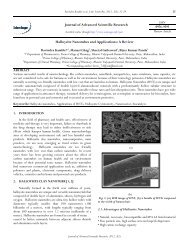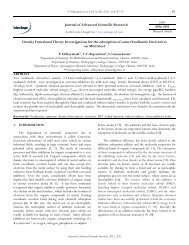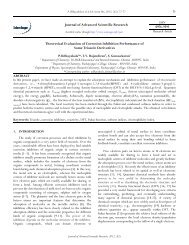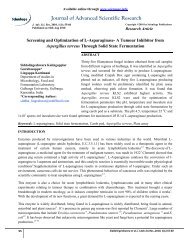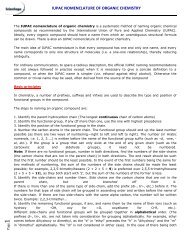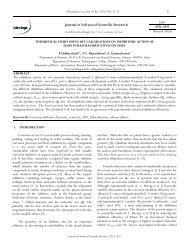Journal of Advanced Scientific Research ... - Sciensage.info
Journal of Advanced Scientific Research ... - Sciensage.info
Journal of Advanced Scientific Research ... - Sciensage.info
You also want an ePaper? Increase the reach of your titles
YUMPU automatically turns print PDFs into web optimized ePapers that Google loves.
Hamoudi Nehad et al, J Adv Sci Res, 2012, 3(3): 46-50 46<br />
<strong>Journal</strong> <strong>of</strong> <strong>Advanced</strong> <strong>Scientific</strong> <strong>Research</strong><br />
Available online through http://www.sciensage.<strong>info</strong>/jasr<br />
ISSN<br />
0976-9595<br />
<strong>Research</strong> Article<br />
Assessment <strong>of</strong> Knowledge and Awareness <strong>of</strong> Diabetic and Non-Diabetic Population Towards Diabetes<br />
Mellitus in Kaduna, Nigeria<br />
Nehad M. Hamoudi 1* , Istabraq Dhia Al Ayoubi 2 , Jyothi Vanama 1 , Husain Yahaya 3 , Umar Farouq Usman 4<br />
1 College <strong>of</strong> Pharmacy, Gulf Medical University, Ajman, UAE, P.O.Box 4184<br />
2 College <strong>of</strong> business administration, Al-Ain University <strong>of</strong> Science and Technology Al-Ain, UAE, P.O.Box 64141<br />
3 Chief Medical Director, Barau Dikko Specialist Hospital, Kaduna, Nigeria, P.O. Box 9727<br />
4 College <strong>of</strong> Medicine, Gulf Medical University, Ajman, UAE, P.O.Box 4184<br />
*Corresponding author: nehadmahdi@hotmail.com<br />
ABSTRACT<br />
This study was aimed to assess the knowledge and awareness among diabetic and non diabetic Nigerian population in Kaduna state<br />
towards diabetes mellitus (DM) different knowledge domain and, to evaluate diabetic patients’ awareness towards anti-diabetic<br />
therapy, hypoglycemia management and their practical approach towards DM control. This was a cross-sectional study based on<br />
validated, self administered questionnaire. Three hundred forty (340) subjects included 33.7% diabetic subjects and 66.2% non<br />
diabetic participants attending NNPC-industrial clinic and Barau Dikko specialist hospital Kaduna, Nigeria. 78.96% <strong>of</strong> total<br />
participants have good knowledge towards DM etiology, disease monitoring (70.6%), management (57.1%), and physical control<br />
(52.7%). Average knowledge was recorded towards DM clinical manifestation (47.5%) and complication (42.4%). Low knowledge<br />
response (38.3%) towards risk problems associated with high blood pressure. 35% <strong>of</strong> diabetic participants missed some doses <strong>of</strong><br />
their anti-diabetic drug. 34.2% <strong>of</strong> diabetic participants are not aware about hypoglycemic symptoms and 53.8% not aware about<br />
management <strong>of</strong> these symptoms. 47.9% <strong>of</strong> diabetic participants did not have eye examination and 30.8% did not have urine test.<br />
Employed participants with age group 40-60 years have significant knowledge towards DM etiology and complication (P< 0.005).<br />
Diabetic female was significantly aware about practical management and control <strong>of</strong> DM (P
about anti-diabetic drug utilization and adherence,<br />
hypoglycemia management and their practice towards the<br />
management and control <strong>of</strong> DM.<br />
2. MATERIAL AND METHODS<br />
A cross-sectional observational knowledge and practice<br />
study was performed among diabetic and non diabetic old<br />
inhabitant in Nigeria population who were attending NNPCindustrial<br />
clinic and Barau Dikko specialist hospital Kaduna/<br />
Nigeria. A nonrandomized sampling strategy was used.<br />
Inclusion criteria diabetic patients, with Type 1 or Type 2<br />
diabetes mellitus, and non diabetic individuals who willing to<br />
participate in this study. Collection <strong>of</strong> data was done twice<br />
weekly during the period between April and July 2011. A selfadministered<br />
questionnaire was used as a tool for data<br />
collection. The questionnaire was prepared by the investigators<br />
and validated by two specialists [one community medicine and<br />
one clinical pharmacist]. The questionnaire was divided into<br />
two parts. The first part included <strong>info</strong>rmation on sociodemographic<br />
characteristics <strong>of</strong> the participants (gender, age,<br />
education and occupation). The second part included twenty<br />
questions focused on the knowledge <strong>of</strong> diabetes etiology (high<br />
blood sugar and low insulin level in blood), clinical<br />
manifestation (increased thirst, urination frequency, tiredness<br />
and slow healing <strong>of</strong> wound), complications ( eye and kidney<br />
problems, foot ulcers and heart problems), management by life<br />
style modification required for diabetic (weight reduction,<br />
stopping smoking and alcohol), factors help in controlling<br />
blood sugar (regular exercise, blood sugar monitoring, planned<br />
diet, medication and education), antidiabetic drug used in DM<br />
treatment (insulin, metformin, giburide), drug therapy<br />
Hamoudi Nehad et al, J Adv Sci Res, 2012, 3(3): 46-50 47<br />
utilization and adherence (diabetic medicine can be stopped<br />
immediately, after one month or should be continued lifelong,<br />
and can diabetic person miss his/her medication dose),<br />
monitoring method (checking blood or urine sugar level),<br />
hypoglycemic symptoms (weakness, confusion, visual<br />
disturbances), hypoglycemia management (taking sugar, or<br />
medicines or insulin), various diagnostic domain involved in<br />
controlling DM (frequency <strong>of</strong> eye examination, urine test and<br />
blood pressure test recommended for diabetic patients). Data<br />
was analyzed using SPSS s<strong>of</strong>tware version17. Proportions and<br />
percentages were used to summarize categorical variables. Chisquare<br />
test examined the association between variables. Data<br />
collection from Nigeria was done by two pr<strong>of</strong>essionals under<br />
the supervision <strong>of</strong> specialist doctor.<br />
Ethical considerations: The study was approved by the<br />
Ethics Committee <strong>of</strong> the Gulf Medical University. Verbal<br />
consent was taken from the participants before enrollment in<br />
the study. Confidentiality <strong>of</strong> the participants was preserved.<br />
3. RESULTS<br />
Table 1: Demographic Characteristics <strong>of</strong> Participants<br />
Total 347 participants were included in the study, 230 (66.2%)<br />
non diabetic (ND) subjects and 117 (33.7%) diabetic (D)<br />
subjects, 45.8% males and 54.2% females. Their ages ranged<br />
between 15-65 years. Table 1 shows demographic<br />
characteristics <strong>of</strong> participants. The highest age group <strong>of</strong> total<br />
participants is below 40 years 53.9% (n=187) and 46.1%<br />
(n=160) above 40 years. The highest educated group for both<br />
diabetic and non diabetic participants have diploma 61.7%<br />
(n=214). 55.3% (n=192) <strong>of</strong> participants are employed.<br />
Gender Male number ( % )<br />
159 (45.82)<br />
Female number ( % )<br />
188 (54.18)<br />
Total ( % )<br />
347 (100)<br />
D (35) ND (124) D (82) ND (106) D (117) ND (230)<br />
Age years<br />
40* 16 ( 45.72 ) 33 ( 26.61 ) 55 (67.07) 56(52.83) 71(60.69) 89(38.69)<br />
Level <strong>of</strong> education<br />
illiterate 0 ( 0.0 ) 1 ( 0.8 ) 3 ( 3.7 ) 2 (1.9 ) 3 ( 2.6 ) 3 (1.3 )<br />
Diploma 29( 82.8 ) 52 ( 41.9 ) 64 ( 78.0 ) 69 ( 65.1 ) 93 ( 79.5 ) 121 ( 52.6 )<br />
Graduation 6 (17.2 ) 71 ( 57.2 ) 15 ( 18.3 ) 35 (33.0 ) 21 (17.9 ) 106 ( 46.1 )<br />
Occupation<br />
Employed* 34( 97.1 ) 74( 59.68 ) 38 ( 46.34 ) 46 ( 43.4 ) 72 (61.54 ) 120 (52.17 )<br />
Unemployed 1 (2.9 ) 50 (40.32 ) 44 ( 53.66 ) 60 (56.6 ) 45 (38.46 ) 110 ( 47.83 )<br />
*P< 0.005<br />
Table 2 shows comparison between diabetic and non<br />
diabetic subjects percentage correct response towards different<br />
diabetes knowledge domain. The higher percentage correct<br />
knowledge response was recorded for DM etiology 72%<br />
(n=85) for diabetic subjects and 82.2% (n=189) for non<br />
diabetic participants. Followed by DM monitoring 70.1%<br />
(n=82) for diabetic subjects and 70.9% (n=163) for non<br />
diabetic subjects. DM management through life style<br />
modification records 56.4% (n=66) for diabetic subjects and<br />
57.4% (n=132) for non diabetic subjects. Both diabetic and<br />
<strong>Journal</strong> <strong>of</strong> <strong>Advanced</strong> <strong>Scientific</strong> <strong>Research</strong>, 2012, 3(3)
non diabetic participants have good knowledge towards DM<br />
physical control by planned diet and regular exercise 52.1%<br />
(n=61) for diabetic and 53.04% (n=122) non diabetic<br />
subjects. Average knowledge response was recorded for DM<br />
clinical manifestation 50.4% (n=59) for diabetic and 46%<br />
(n=106) for non diabetic subjects. Followed by DM<br />
Hamoudi Nehad et al, J Adv Sci Res, 2012, 3(3): 46-50 48<br />
complication 53% (n=62) for diabetic subjects and 36.9%<br />
(n=85) for non diabetic subjects. The lowest knowledge<br />
response was recorded for risk problems associated with high<br />
blood pressure in patients with DM. 41.9% (n=49) diabetic<br />
and 36.5% (n=84) non diabetic subjects.<br />
Table 2: Number (%) <strong>of</strong> Participants Correct Response towards DM Knowledge Domains<br />
Knowledge Domain Diabetic subjects (n=117) Non-Diabetic subjects (n=230) Total<br />
100%<br />
Male, n=35 Female, n=82 Male, n=124 Female, n=106 (n=347)<br />
(% Response) (% Response) (% Response) (% Response)<br />
*Etiology 29 (82.9) 56 (68.3) 102 (82.3) 87 (82.1) 78.96<br />
Clinical Manifestation 16 (45.7) 43 (52.4) 57 (46.0) 49 (46.2) 47.5<br />
*Complications 21 (60.0) 41 (50.0) 48 (38.7) 37 (34.9) 42.4<br />
B.P Risk Factors 19 (54.3) 30 (36.6) 47 (37.9) 37(34.9) 38.3<br />
Management 21(60) 45 (54.8) 73 (58.8) 59(55.6) 57.1<br />
Physical Control 19 (54.3) 42(51.2) 64 (51.6) 58 (54.7) 52.7<br />
Monitoring 28(80.0) 54(65.9) 84(67.7) 79(74.5) 70.6<br />
*P< 0.005<br />
Table 3: Comparison Between Diabetic and Non Diabetic Subjects Knowledge Response<br />
Variable<br />
Diabetic subjects<br />
n=117<br />
Non-Diabetic<br />
subjects n=230<br />
Total (100%)<br />
n =347<br />
(% Response) (% Response) (% Response)<br />
Management by life style<br />
modification<br />
Weight reduction 18 (15.4) 20 (8.3) 38(11.0)<br />
Stopping smoking 6 (5.1 ) 7 (3.0) 13(3.7)<br />
Stopping alcohol 2 (1.7) 28 (12.2) 30(8.6)<br />
All above 66 (56.4) 132 (57.4) 198(57.1)<br />
Don’t know 24 (20.5) 38 (16.5) 62(17.9)<br />
Type <strong>of</strong> Complication<br />
Eye problem 12 (10.3) 25 (10.9) 37(10.7)<br />
Kidney problem 10 (8.5) 40 (17.4) 50(14.4)<br />
Foot ulcer 7 (6.0) 14 (6.1) 21(6.1)<br />
Heart problem 6 (5.1) 19 (8.3) 25(7.2)<br />
All above 66 (56) 85 (37) 147(42.4)<br />
Don’t know 20 (17.1) 43 (18.7) 63(18.2)<br />
High blood pressure risk<br />
Heart attack 13(11.1) 22(9.6) 35(10.1)<br />
Stroke 8(6.8) 36(15.7) 44(12.7)<br />
Eye problem 8(6.8) 9(3.9) 17(4.9)<br />
Kidney problem 8(6.8) 28(12.2) 36(10.4)<br />
All the above 49(41.9) 84(36.5) 133(38.3)<br />
Don’t know 31(26.5) 42(18.3) 73(21)<br />
Comparison between diabetic and non diabetic subjects<br />
knowledge towards the management <strong>of</strong> DM through life style<br />
modification, DM complication and risk problems associated<br />
with high blood pressure in diabetic patients is shown in table<br />
3. About 21% <strong>of</strong> diabetic subjects are unaware about the<br />
management <strong>of</strong> DM by life style modification. Diabetes<br />
Mellitus if not treated can lead to different complication<br />
problems, 17% <strong>of</strong> diabetic subjects are unaware about these<br />
complications. About 27% <strong>of</strong> diabetic subjects are unaware<br />
about risk problems associated with high blood pressure during<br />
diabetes mellitus.<br />
Diabetic participants’ awareness about antidiabetic therapy<br />
they used in the treatment <strong>of</strong> DM is low. 41% <strong>of</strong> diabetic<br />
participants don’t know the name <strong>of</strong> antidiabetic drug they<br />
utilized. About 15% said by antibiotic, 25% insulin, 12%<br />
<strong>Journal</strong> <strong>of</strong> <strong>Advanced</strong> <strong>Scientific</strong> <strong>Research</strong>, 2012, 3(3)
metformin. Diabetic subjects awareness about antidiabetic drug<br />
utilization is low. 44.9% said antidiabetic therapy should be<br />
continued lifelong while 11.5% therapy can be stopped<br />
immediately after improvement <strong>of</strong> sugar level, 7.5% can be<br />
stopped after one month and 36% don’t know. Diabetic<br />
participants’ adherence to their therapy is low. 35% <strong>of</strong> diabetic<br />
participants missed the doses <strong>of</strong> their diabetic medications.<br />
Frequency <strong>of</strong> dose missing was varied 20.5% said occasionally,<br />
8.5% once a week and 6% once a month.<br />
Hypoglycemia may occur during the treatment with<br />
antidiabetic therapy. Table 4 shows the comparison between<br />
diabetic male and female knowledge percentage response<br />
towards hypoglycemic symptoms. 67.07% (n=55) <strong>of</strong> female<br />
are aware about hypoglycemic symptoms compared with<br />
62.85% (n=22) for male.<br />
Table 4: Comparison between Diabetic Male and Female (%)<br />
Correct Knowledge Response towards Hypoglycemic Symptoms<br />
Diabetic Total 100%<br />
Symptoms Male, n=35<br />
(% Response)<br />
Female, n=82<br />
(% Response)<br />
(n=117)<br />
(%Response)<br />
Weakness 13 (37.1 ) 37 ( 45.1) 50 ( 42.7 )<br />
Confusion 6 (17.1 ) 8 (9.8) 14 ( 12.0 )<br />
Visual<br />
disturbances<br />
3 ( 8.5) 10 ( 12.2 ) 13 ( 11.1 )<br />
Don’t know 12 ( 34.2) 28 ( 34.1) 40 ( 34.2 )<br />
53.8% (n=63) <strong>of</strong> diabetic participants are unaware about<br />
the management <strong>of</strong> hypoglycemic symptoms. Surprisingly<br />
about 10% <strong>of</strong> diabetic participants said by insulin.<br />
Table 5 shows the practical approach <strong>of</strong> diabetic<br />
participants towards DM control by measuring blood pressure,<br />
eye examination and urine analysis was examined. 10% never<br />
check their blood pressure (BP), 47.9% did not have eye<br />
examination and 30.8% did not have urine test.<br />
Table 5: Number (%) <strong>of</strong> participants who have correct<br />
knowledge in various aspects<br />
Various Aspects<br />
Male, n=148<br />
(% Response)<br />
*Female,n=87<br />
(% Response)<br />
Eye examination 42 (28.4) 37 (42.5) 33.6<br />
Urine test 68 (45.9) 25 (28.7) 39.6<br />
Blood sugar test 130 (87.8) 75 (86.2) 87.2<br />
Blood pressure<br />
31 (20.9) 25 (28.7) 23.8<br />
Hamoudi Nehad et al, J Adv Sci Res, 2012, 3(3): 46-50 49<br />
Total 100 %<br />
( n= 235) %<br />
(no)<br />
test<br />
*P< 0.005<br />
Results showed that employed participants with age group<br />
40-60 years have significant knowledge towards DM etiology<br />
and complication (P< 0.005). There is no significant difference<br />
observed between male and female regarding different<br />
knowledge domain <strong>of</strong> DM. Diabetic female was significantly<br />
aware about practical management and control <strong>of</strong> DM than<br />
male regarding blood pressure test and eye examination<br />
(P
agents is frequently necessary to maintain glucose control [23].<br />
In this study 34.2% <strong>of</strong> diabetic participants are unaware about<br />
hypoglycemic symptoms and 53.8% are unaware about the<br />
management <strong>of</strong> hypoglycemia, so education <strong>of</strong> people about<br />
management <strong>of</strong> hypoglycemia is required. Well-planned short<br />
education programmes are useful in improving knowledge and<br />
in creating enthusiasm to improve diabetes care and awareness<br />
[24]. Control and prevention <strong>of</strong> diabetes requires a<br />
multidisciplinary and multisectorial integrated approach [25]<br />
concentrating on a community and primary care approach.<br />
Education, lifestyle and behavior change are also vital elements<br />
<strong>of</strong> control and prevention [26].<br />
This study highlighted the need <strong>of</strong> people in Kaduna state<br />
in Nigeria for better health <strong>info</strong>rmation through large scale<br />
awareness interventions regarding diabetes mellitus. This may<br />
be achieved by using audio-visual aids, as well as posters<br />
showing patients with diabetes complications and their<br />
consequences such as lower limb amputation, blindness and<br />
renal dialysis; hypoglycemic symptoms after drug treatment<br />
such as weakness, confusion, and visual disturbances and how<br />
to control hypoglycemia. In addition diabetic patient adherence<br />
to their anti-diabetic therapy can be achieved through patient<br />
counseling by clinical pharmacist or health pr<strong>of</strong>essional to<br />
improve diabetes care and can go a long way in the prevention<br />
and management <strong>of</strong> diabetes.<br />
5. ACKNOWLEDGEMENT<br />
The authors place on records their sincere thanks to GMCHRC<br />
and <strong>Research</strong> Division/GMU for the help rendered during the<br />
study. Special thanks to NNPC-industrial clinic and Barau<br />
Dikko specialist hospital Kaduna/ Nigeria and Dr. Idris Nuhu<br />
Ibrahim for their cooperation.<br />
6. REFERENCES<br />
1. Nyenwe EA, Odia OJ, Ihekwaba AE, Babatunde S. Diabetes Res<br />
Clin Pract, 2003; 62:177-85.<br />
2. Bakari AG, Onyemelukwe GC, Sani BG, Aliyu IS, Hassan SS,<br />
Aliyu TM. Int J Diabetes & Metabolism, 2007; 15:68-69.<br />
Hamoudi Nehad et al, J Adv Sci Res, 2012, 3(3): 46-50 50<br />
3. International Diabetes Fedration, Africa: Diabetes- deadly,<br />
unfunded and unidentified. 2009,<br />
http://www.irinnews.org/report.aspx? Reported=83280.<br />
4. Okesina AB, Oparinde DP, Akindoyin KA, Erasmus. East Afr<br />
Med J, 1999; 76:212-216.<br />
5. Ogbera AO. Trop Doct, 2007, 37(3):153-154.<br />
6. Ogbera AO, Chineneye S, Onyekwere A, Fasanmade O. Ethn<br />
and Disease, 2007; 17:721-725.<br />
7. Raheem Adaramaja Shehu, Ali Arazeen Abdullai, D. Shade<br />
Adekeye. Ethno Med, 2010; 4(1):15-19.<br />
8. Fitima Bello-Sani, FEO Anumah. Int J Diabetes & Metabolism,<br />
2009; 17:99-104.<br />
9. F Bello-Sani, Bakari AG, Aumahi FE. Int J Diabetes & Metabolism,<br />
2007;15:9-13.<br />
10. Mohan D, Raj D, Shanthiran CS. Assoc Physician J, 2005; 53:<br />
283-87.<br />
11. Wee HL, Ho HK, Lisc. Singapore Med J, 2002; 43:128-34.<br />
12. Petty Re, Cacioppo JT. Communication and Presentation:<br />
Central and Peripheral Routes To Attitude Change. New<br />
Yourk: Springer Verlag, 1986.<br />
13. Young TK, Mustard CA. CMAJ 2001; 164(1):24-28.<br />
14. Harris MI, Flegal KM, Cowie CC. Diabetes Care, 1998; 21:518-<br />
24.<br />
15. Edelman D, Edwards LJ, Olsen MK. J Gen Intern Med,<br />
2002;17(1):23-28<br />
16. Hillier TA, Pedula KL. Diabetes Care, 2001; 24:1522-27.<br />
17. Agaba IE, Anteyi EA, Puepet FH, Omudu PA, Idoko JA.<br />
Highland Medical <strong>Research</strong> <strong>Journal</strong>, 2002; 1:22-24.<br />
18. Ayodeji Arije, Modupe Kuti, Adesoji Fasonmade, Kehinde<br />
Akinlade et al. Int J Diabet & Metabolism, 2007; 15: 82-86.<br />
19. Grandy S, Chapman RH, Fox KM. Int J Clin Pract, 2008;<br />
62:562-68.<br />
20. American Diabetes Association. Diabetes and retinopathy (eye<br />
complications). Available at: (www.diabetes.org/diabetesstatistics/eye<br />
complications.jsp). Accessed March 14, 2005.<br />
21. American Diabetes Association. Diabetes Care, 2005; 28(suppl<br />
1):S4-S36.<br />
22. Cooppan R. Postgrad Med. 2003; 113:59-64.<br />
23. White JR Jr, Davis SN, Cooppan R. Clin Diabetes, 2003; 21:14-<br />
21.<br />
24. Murugesan N, Shobana R, Snehaltha C. Diabetes <strong>Research</strong> and<br />
Clinical Practice, 2009; 83:140-44.<br />
25. Sambo L. Africa must check the growing incidence <strong>of</strong> diabetes.<br />
WHO/AFRO Press Release 2007.<br />
26. Issa BA, Baiyewu O. Hong Kong J Psychiat, 2006; 16:27-33.<br />
<strong>Journal</strong> <strong>of</strong> <strong>Advanced</strong> <strong>Scientific</strong> <strong>Research</strong>, 2012, 3(3)


